I was honored once again to represent Wikipedia at the 2017 Information Architecture Summit team is in Vancouver last month. The IA Summit is an annual conference of the Association for Information Science and Technology (ASIS&T). It was hosted at the Hyatt Regency Vancouver on March 22-26 where I led two Wikipedia sessions. On Saturday afternoon, March 25, I presented a talk called Diversity and Inclusion in Wikipedia which was aligned with the conference theme of diversity in information architecture and UX design. Then on Sunday, March 26, I hosted a Wikipedia IA Edit-a-thon during the lunch session.
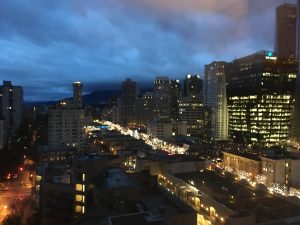
Prior to the session, my husband and I did some sightseeing to take in the diversity of the city. After breakfast in Gastown Friday morning, we stopped at the Vancouver Police Museum, which is in a poor neighborhood, with remnants of women’s residences and SROs, soup kitchens and storefront churches. The museum is located in the former Coroner’s Building, next to an active police station. We almost didn’t go into the museum, due to a homeless man sleeping in the entrance, with his blanket and the remains of a meal from the prior night. We wondered if maybe it was not open that day, but as we were turning to leave, a docent arrived with the keys to open up. She later told us that the man has been a regular feature at the museum for about three years. They do what they can to make sure he is safe and warm, she said, but the city is unfortunately seeing an epidemic of drug use and homelessness, and has been forced to become very creative in addressing the problem.
Inside the museum were exhibits on confiscated weapons, youth gangs and unsolved murders, and a preserved coroner’s exam room with two examining tables and a bullet hole in the window over one of the sinks. The story behind it was classic gangster: Someone didn’t want evidence revealed, so they tried to assassinate the Coroner while he was performing an autopsy. The Coroner survived and the shooter was charged.
As interesting as that was, I was there to explore diversity so I turned to the exhibit on youth violence. Many groups were represented including (Southeast Asian) Indian, White, First Nation and other groups. The exhibit addressed the challenges of policing in a diverse community and offered ways to promote dialog between youth and law enforcement. It was a thought-provoking display.
[quote align=”center” color=”#999999″]Not all people who self-identify or are identified with the same group share he same outlooks, values or ideas.”[/quote]
I found the following panel which provides good insight for being sensitive to diverse populations, and which I mentioned during my talk, since it calls to mind the sensitivity needed when describing people or groups in a Wikipedia article.
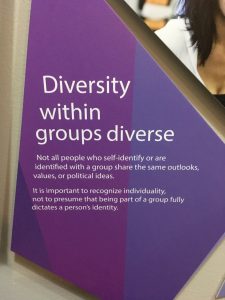
After the Police Museum, we took a walk around Vancouver’s historic Chinatown, led by tour guide Robert Sung, to learn about one of the many diverse groups who have made their home in one of the Pacific Northwest’s most diverse and beautiful cities. During the tour, which included Dr. Sun Yat Sen Garden, pastry and BBQ pork shops, an herbal remedy store, a Buddhist temple and a master tea salon, we learned about the community’s quest for balance between older ways and assimilation with BC culture. Our guide described not only the Chinese population but also the population of addicted drug users living in the neighborhood. At a statue commemorating the Chinese participation in the railroads and World War II, an older Chinese woman approached us, smoking marijuana. She smiled and greeted us, politely tapped out her joint, placed it in a container, and proceeded to explain her point of view as to what British Columbia owes to the Chinese settlers. Our guide thanked her for offering her point of view, and we went on to get dim sum.
Back at the Hyatt the next day, and setting the stage for my presentation was a very interesting panel discussion, Indigitization: Supporting the Digitization, Preservation, and Management of Indigenous Community Knowledge, discussing the University of British Columbia’s Indigitization project, an effort to preserve fragments of indigenous community knowledge on rapidly deteriorating magnetic media. Panelists included Alissa Cherry, research manager at the Audrey & Harry Hawthorn Library & Archives at the Museum of Anthropology at UBC, Sarah DuPont, Indigitization project manager and Aboriginal Engagement Librarian at UBC Library, and Indigitization project technology lead, Gerry Lawson, a member of the Heiltsuk First Nations and coordinator for the Oral History and Language Lab, at the UBC Museum of Anthropology.
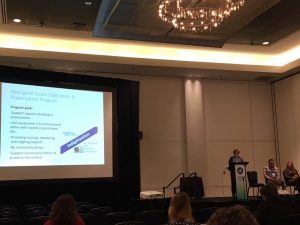
[quote align=”center” color=”#999999″]“The panelists in this session share an awareness that existing information practices are firmly rooted in Western knowledge systems that are not always appropriate when dealing with Indigenous traditional knowledge” — IA Summit Featured Events email[/quote]
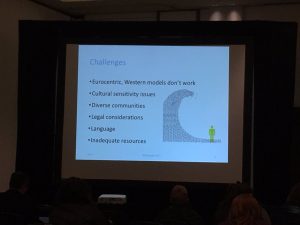
Following this panel, my session on Diversity and Inclusion covered efforts by The Wikimedia Foundation (WMF) to improve the creation and discovery of content about underrepresented groups. I spoke about WMF funded projects like Women in Red, Art+Feminism, Wiki Loves Pride, AfroCROWD, Indigenous Film and Media and Indigenous Storytellers WikiThon. I presented a deck that included many of the slides from the Art + Feminism training presentation, showing ways that Wikipedia content rules may both support diversity and inadvertently promote bias, as well as ways IA professionals can develop considered approaches to improving discoverability within Wikipedia guidelines by employing strategic tagging, categories and linked Wikidata. I encouraged participants to seek out and attend Wikipedia events in their area.
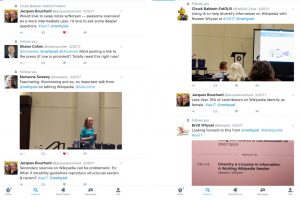
On Sunday, March 26, I hosted a Wikipedia editathon during the lunch session. While brief relative to a more traditional Wikipedia edit-a-thon, this session was meant to give attendees an opportunity to learn about editing tools that may be useful to information architects and knowledge professionals and also presented an easy way to make a meaningful contribution to the encyclopedia.
We welcomed student volunteers and facilitators from the IA community as well as the local Vancouver area to help out at the Edit-a-thon. This was a great opportunity for community engagement at one of the premier Information Architecture conferences. Unfortunately a UBC librarian (and Vancouver Wikimedian) whom I had invited to help facilitate was unable to attend due to illness. I didn’t blame anyone for not wanting to come into town, as it was a rather dreary, rainy weekend.
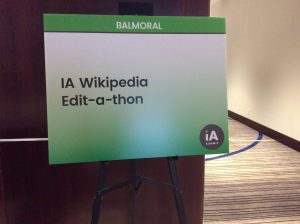
Ten people attended the Edit-a-thon lunch, including three facilitators. Conference co-chair Marianne Sweeny, Veronica Erb and myself helped walk new users through how to edit and save an article, add a category and select articles to work on from the event dashboard. About half of the attendees already had Wikipedia editing experience and half were new to editing. Most understood how to make edits and were curious about Wikidata and categorization tools. Most of the attendees signed into the dashboard and assigned themselves an article. A few felt confident enough to make some contributions.
I was hoping to recruit editors for WikiProject Information Architecture, which has a dual purpose to make Information Architecture tools and processes discoverable and to offer our IA experience to the Wikipedia community to improve discoverability of topics generally. Since the session was short, roughly 45 minutes including retrieving a lunch from another floor, we anticipated mostly learning and a small amount of editing. That said, seven people made contributions to pages tagged by WikiProject Information Architecture including at least one person working offsite.
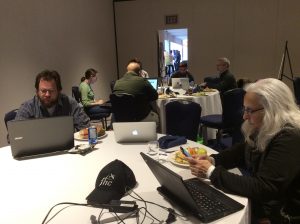
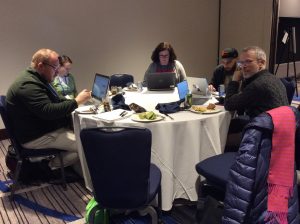
We tried out the new Outreach Dashboard from WMF Labs for tracking Wikipedia editing events and found it to be quite simple to use, though not all participants registered and it wasn’t clear that all pages the attendees worked on were included. As an information tool, the dashboard helps keep track of who registered (by Wikipedia username), which articles they worked on, how many edits they made and the total data added in kilobytes. A full count of the impact of the session will be included on the WikiProject Information Architecture site.
In spite of being a brief session, I believe we made a strong case for bringing information architecture skills to the table, so to speak, to improve information in Wikipedia. New editors were quite interested in the power of infoboxes and Wikidata to reach beyond the encyclopedia to augment discovery of important topics. Alas, I was disappointed to find when I returned home that WikiProject Information Architecture was marked for deletion, pending an explanation and evidence for preserving these efforts. I was grateful this didn’t happen before my event, but acknowledge that it has been difficult to move the community beyond the kind of support that gets Wikipedia sessions on the schedule at a major conference toward active participation and hands on editing. My aspiration is that if I have engaged forty people to attend a talk about diversity in Wikipedia and ten people to participate in an Edit-a-thon, perhaps more will follow.
Anyone who may be interested in participation should sign up and start editing at WikiProject Information Architecture: https://en.wikipedia.org/wiki/Wikipedia:WikiProject_Information_Architecture.
Links:
Diversity and Inclusion in Wikipedia Slide Deck: https://www.slideshare.net/mobile/nwhysel/diversity-and-inclusion-in-wikipedia
IA Wikipedia Edit-a-Thon Training Deck: https://www.slideshare.net/mobile/nwhysel/ia-wikipedia-editathon
WikiProject Information Architecture: https://en.wikipedia.org/wiki/Wikipedia:WikiProject_Information_Architecture
IA Summit Vancouver: http://iasummit.org
Wikipedia Session Descriptions: https://iasummit2017.sched.com/type/community+working+session
Outreach Dashboard: https://outreachdashboard.wmflabs.org/courses/Information_Architecture_Summit/IA_and_Wikipedia/students
